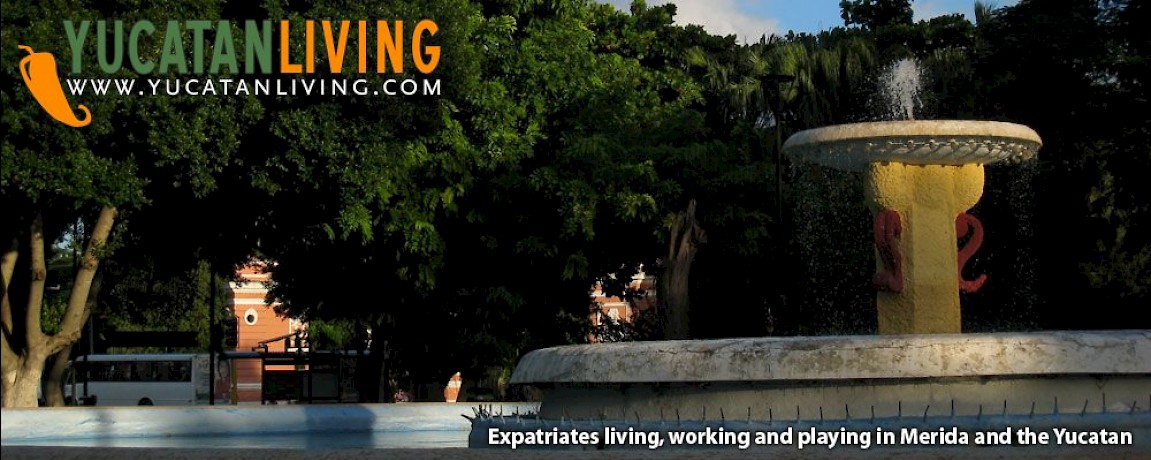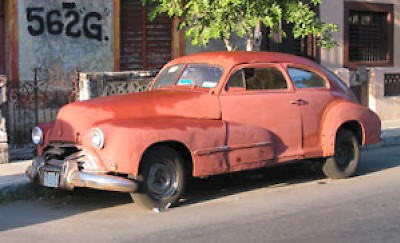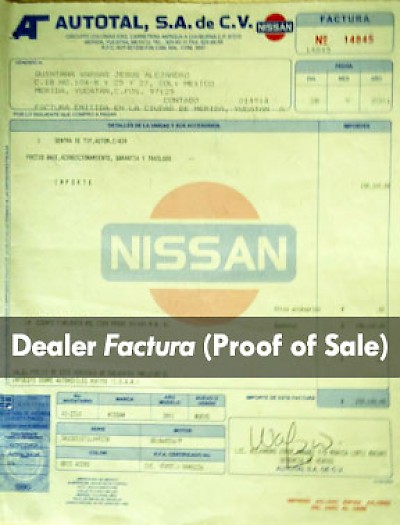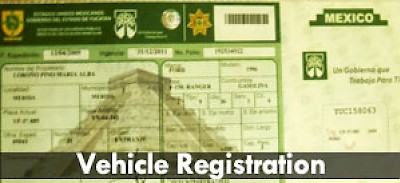Buying A Used Car in Merida
>
Editor's Note: Dr. Steven Fry is one of Yucatan Living's regular contributors, and has been a resident of Merida for many years. He also happens to be a guy who likes to know how things work and then write about them. In this article he shares his observations and experience about buying a used car. We're pleased to say that there are some great tips here, whether you are looking in the Yucatan or the Yukon. We welcome your thoughts, comments and questions in the Comments section after the article.
Buying a Used Car in the Yucatan
Here in Yucatan, the prices asked for used cars are all over the map. After some research, you will learn that used cars don't seem to lose value in Mexico like they do in the United States or Canada. Some people have reported to us that a five year old Yucatecan car can cost nearly as much as a new one, making moot the point of buying a coche "semi-nuevo" (used car). That said, in our most recent personal purchase of a used car in Merida, we found a 6-year-old used Nissan Sentra for $60,000 pesos (about $4,500 USD) in 2 weeks, with just 40,000 miles, and in good-to-excellent condition.
Many of our friends have asked if there are any "inside tips" on how to value and buy a car in our local market. This task is especially challenging because in this area, cars are likely to be beaten up by topes (those ubiquitous speed bumps), country roads and potholes, as well as suffer damage from the vagaries of a tropical climate, the hot sun and the marine influence.
Most ordinary buyers are not qualified to do mechanical checks of cars. The average person's knowledge limits them to checking out the body, the interior, and the tires, and maybe doing simple motor oil & transmission oil dipstick checks, and exhaust system checks. But with that in mind, we offer the following advice, insight, tips and hints to help you become an above-average used car buyer.
Start with Research
Do your research and take your time if you can. Because the market is so diverse, there are deals to be found if you know what you are looking for. Do not feel forced to buy any used car. The process is a lot like dating: it helps to remember that there are lots of fish in the sea, as your mother used to tell you. If you can afford the time, it pays to wait for the right one!
Secondly, we suggest you pick a few models that you like and start the pricing process with the Kelley Blue Book. Check the Private Party used car values and also check Auto Trader's comparable values from a reasonable market like Colorado (e.g. Fort Collins, zip code 80521. More accurate than high-value markets like San Francisco or NYC) (See links at the end of this article). After you determine a "blue book" value, add 15% - 20% to start to accommodate import tariff costs. Then, check the price guide on the Autoplaza website (linked at the end of the article). This website has a Used Car pricing guide for all of Mexico, much like the Kelley Blue Book guide that you might be used to. Once you have all these points of information, you should be able to extrapolate a range of upper and lower prices for the cars you are interested in.
Tips For Checking A Used Car
Now you are ready to go look at some used cars! Here is a list of quick and easy things to look for when you are evaluating the "health" of a used car:
- Only look at cars in the daytime, in good light, and bring a rag with you.
- Check the Fit and Finish.
- Use the magnet trick to identify plastic or fiberglass repairs.
- Look at the paint color in the trunk compared to the exterior color for repainting issues.
- While in the trunk, also look under the mat and around the spare tire for stressed metal, cracked paint, broken glass, rust or mud. Even a careful detailing usually will not reach the area around the spare tire.
- Notice how the doors, hood, and trunk-lid align and fit with the body, looking for constant reveals.
- Look under the hood for evidence of previous wrecks: rusted or bent metal, spider-cracked paint, non-matching paint, etc.
- While under the hood, look at the oil dipstick and transmission dipstick for signs of burning (roasted or heavily discolored metal is not a good sign), or blackened fluid.
- Open the oil filler cap and use your rag to wipe up-inside the valve cover with your finger or your rag.
- Heavy gunk or burned gunk or smelly gunk is not good, as it is evidence of running too hot for too long & without sufficient oil changes.
- Greyish or whitish gunk is really not good, as it indicates the mixture of coolant+oil emulsion, which in turn indicates a blown head gasket.
- When you pull the transmission dip-stick, smell the fluid. It should smell new - not musty, not funky, not burned.
- Open the cap on the brake fluid reservoir.
- The brake fluid should be clear and colorless.
- Dark fluid or rusty fluid is not good – not a deal buster, but it can be an indication of problems and should certainly indicate more price-negotiating leverage.
Paint Issues
If you observe different paint shades between the trunk or hood interior and the car's exterior, here are a few things to keep in mind. Repainting is okay; in fact, unless a car has been religiously garaged, repainting can be expected on older used cars. The hot tropical sun is brutal on car paint, especially on the hood or roof of the car.
However, the value of the car is less if it received a low-quality paint job. Look at the paint surface using reflecting angles and grazing angles to observe any subtle dents or ripples, dust in the paint, puddling, differences in gloss, (caused by many back-yard shops who do not clear-coat their re-painted areas), depth of color, or oxidation. Check especially the roof, hood, fenders and doors, and the trunk lid. A sharp, good quality paint job can be almost as good as the factory paint job. A cheap paint job can add up to $500 USD to the value of the car, or nothing at all if it is really bad. A good paint job, or a garage-kept car, can add as much as $2,000 USD to the value of the car. The strong sun here oxidizes even good paint jobs after 6-10 years, so many slightly-older but good used cars are repainted here.
Other Issues
To do a quick exhaust system inspection, block the tailpipe tightly with your hand covered by your rag while the motor is running. The motor should bog down or threaten to stall out. Even if the motor coughs, there might be small leaks. Listen for chuffing (this requires having one person to block the exhaust pipe, while the other person walks up to the front of the car to listen).
It is also good to know the condition of the tires when you buy a used car. If you do not know tire costs locally, then check out tire prices beforehand for the vehicle of interest to get an idea of what a new set of good quality tires cost for that vehicle. Older tires with good tread can still have some tread separation or belt crawling issues, due to tope and pothole damage, so look for damage and surface irregularities too that do not normally occur in Canada or the USA. Cheap small tires cost $400 pesos each in Merida, and high-end, large tires can cost $1,500 - $1,800 pesos or more each.
When looking at tires, you can check the shocks and struts for fluid leakage by looking under the car. You can also stress the springs and shocks by rhythmically and vigorously bouncing each bumper's corner, up and down. If all is well, the corner should dip just once more and come to a stop after you stop jouncing the suspension. Squeaking is not good. Also, more than a half bounce or partial full bounce (partial or damped up-down cycle) means the car has strut problems (if the problem is on the front) or shock absorber problems (if the problem is on the rear) in a vehicle with a solid axle. If the car has four-wheel independent suspension, then more than a partial bounce on the rear could also mean strut problems, which are expensive. Shock absorber problems are less expensive.
If you feel adventurous, get down on your knees at each front corner and inspect the CV joint boots. Torn boots might mean boot replacement or could require an entire axle replacement, depending on how much grit entered the torn boot. If it is a recent tear on a non-beach car, then the axle could still be in good shape. If you feel exceptionally adventurous, wipe the inside of the torn boot with your finger, and rub the grease between your fingers to check for grit. If there is no grit, that's a good thing. If there is a lot of grit, or if you hear clicking when you drive the car through an extreme right-hand or left-hand turn, that probably means you are going to need a new axle.
The Harsh Environment of the Yucatan
As you go through the process, remember that typical Yucatecan roads exact a harsh toll and can cause hard wear on cars here. Unexpected topes and random potholes can take a serious toll on suspension parts and tires). Heavy stop-and go-driving, especially with "jackrabbit" starts and stops, is very hard on motors, brakes, transmissions and clutches. While the roads in the Yucatan get better every year, the average Yucatecan still does not go through any sort of driver training, and certain bad driving habits can also be tough on a car.
Negotiate with the Seller
As you would in your home country, plan ahead to be firm. Be prepared to walk at any point, and tentatively start to walk away if the seller is asking an outrageous price and won't budge. Make it clear that you have cash in hand. Bring a printout of the KBB page for the car you want to show the seller an "official" price, giving your offer credibility.
As you see any problems during your inspection, point them out to the seller. This establishes your credibility as a knowledgeable buyer, and subtly, step-by-step, gets the buyer into the process of realizing that their "baby" is not as perfect as they imagined. Keep your tone factual and pleasant. You don't want to make the seller defensive, but you want to build momentum on your side.
If you have explained up front that you have cash in hand, show them the official KBB printout and take the time to do these official-looking tests, then the combination of your tests and the evidence of your research is usually enough to impress the typical seller, and give you a negotiating advantage. This approach shows that you mean business, and that you are not some naco just in from his milpa. Conversely, it also demonstrates that you are not some greenhorn gringo with a walletful of easy cash, scheming to cheat the seller with a low-ball insincere offer.
Test Drive the Car
It is a good idea to have the seller drive you somewhere for you to do a test drive. On the way, carefully note how the driver drives and how he or she treats the car. Especially note how the driver acts at stops and starts, going over topes, and whether he or she avoids bumps and potholes. Many short trips mean a lot of wear on the starter and brakes, and also means an exhaust system and a motor that do not heat up to full operating temperatures. Full temperatures burn off condensed water from the exhaust, and that means less rust. If you are lucky, you will hit the jackpot and find a single owner who commutes to Cancun or Chetumal, so that almost all the miles are wonderfully gentle highway miles. 40,000 rough street miles in the city can be equal to 100,000 highway miles on a car's actual mechanical condition.
When considering the value of the car, always remember to ask about and to consider the single owner versus multiple owners issue. A single owner car is usually more valuable, but much has to do with how the car was treated.
One other thing. When you drive the car, smooth acceleration is evidence that the owner used a good fuel system cleaner like Techron ($9 USD per bottle in Yucatan) every 4-5 tankfuls, keeping pumps, injectors, and emissions sensors and valves clean. After time, this translates to a clean fuel and emissions control system. Remember when you are test driving, drive with the windows open on both sides of the car. A car in good condition will exhibit no rattles or squeaks going over a rough street or topes.
Beach area cars should never be a first choice for buying a used car, due to salt and rust issues. If you are considering a car that has been kept or driven at the beach, be sure to investigate these issues thoroughly.
These above tips are a starting point and going through them will teach you a lot about a car. The list is not meant to be complete, but it does include enough "insider's tricks" to give readers a foundation for checking out a used car without touching a wrench, getting dirty, or putting the car on a lift. Even in the Yucatan, cars that have less than 30,000 to 40,000 miles and are less than four years old should not have serious mechanical problems, and may not need an experienced mechanic's inspection. Older or higher mileage cars should definitely be checked out by a qualified mechanic before making any offer.
What Else?
You might have noticed that we left out all the obvious stuff like checking headlights and brake lights, windshield wipers, turn signals, the radio/stereo, door handles and window handles. We left out checking to see if switches and motors function smoothly, if the seats move properly, if seat belts present and working, if the driver's seat is not broken-down, if the car smells like an ashtray or an ashtray full of air freshener, if the windshield is pitted, if the air conditioning is strong (or works at all) and if all the driver's controls & switches are working. We have not told you to sit in the back seat and check out the little things, or to be sure that the driver has the original auto sale document or the owner's manual with original sale documentation sticker to prove that the car is not stolen. We figure you are smart enough to know those things already.
We would caution you, just in case, to check to see that the car's VIN (Vehicle Identification Number) matches the VIN listed on the official sale document.
What About Documents and Paperwork?
Speaking of documents, it is important to know that cars sold in Mexico by new car dealers do not to have a "Title" issued by a State, like in the USA. Instead, the original bill of sale, a factura, functions as the title for the car. Original facturas are identifiable as being printed on official dealer invoice paper (pictured to the left) and have an official Hacienda logo in the lower left corner that contains the dealer's RFC number. If your vehicle's owner is using the original factura, check the back of the factura for handwritten documentation of any prior sales/transfers of the vehicle.
The sale of the vehicle will probably be described as simply as:
"Cedo los derechos que ampara la presente factura a favor de (buyer's name) por asi convenir a mis intereses: " (Printed Name of Seller), Address, Date of Sale, and Seller's signature. (Translation: I grant the rights stated on the invoice to the (buyer's name) because it is in my best interest to do so)
Vehicles that have been permanently imported from outside Mexico by private parties have the title issued by the owner's foreign (USA? Canada?) home state, or the state where the car was registered. The foreign title must be accompanied by a Pedimento, a document from Aduana (Customs) that documents that the vehicle was properly imported under a Permanent Import permit (see on the right). It is worth noting that foreigners can only sell cars with Mexican license plates, and it is prohibited to sell temporarily imported permit cars that have foreign license plates. When a vehicle has a foreign license plate, it is here under the same visa as the owner of the car and cannot be switched to another owner.
Vehicles newer than 2000 may also have an official card issued by the Secretaria de Economía that proves the vehicle was officially registered with Mexico's Registro Nacional de Vehiculos. This Constancia de Inscripcion Vehicular card looks like a credit card, but it has the car's VIN (NIR) number, Model, Motor ID, and Chassis ID. Not all vehicles have these cards, as the original owners must pay roughly $500 pesos to register the car in this national program. All of these measures help prevent the sale of stolen cars.
In addition to these general proof-of-ownership documents that are used across Mexico, Yucatan has several other documents that help prove ownership. Vehicles with Yucatan license plates have a registration document that is called a Tarjeta de Circulación Vehicular issued by the S.S.P. (Secretaria de Seguridad Publica). Owners should keep the original of this current registration in the vehicle at all times (below to the left). Newer Yucatecan-plated vehicles should also have a copy of the proof of payment of the annual tenencia (see below to the right) called the Declaración de Pago del Impuesto Sobre Tenencia, and a windshield holographic sticker (all the way below to the left) from the State of Yucatan which also indicates that your tenencia is paid.
Where to Look for a Used Car
As in your home country, used cars are advertised online. The best place to look online these days include Autoplaza.com.mx, Autosyucatan.com.mx, the classified section in the Diario de Yucatan, YoListo.com's classified section, Yucatan's section of Craigslist, Tacolist and more (all linked below).
If you drive for more than a few hours anywhere in Mexico, you will see cars with dollar signs on the windows. Actually, these are not dollar signs, but they are the symbol for pesos… and in this instance, they signify that the car is for sale. If you see someone driving a car you are interested in, feel free to flag them down or get the phone number on their windshield to find out more. In addition to used car dealers, which we don't think we need to educate you about (they are the same everywhere...), there is at least one official used car market in Merida, where individuals go to sell their cars.
Every Sunday, in the Parque de la Paz (pictured on the banner at the top of the page), between the Zoo and the Ex-Penitentiary, people have come from all around for the last thirty years to sell their cars. It can get to be a pretty festive atmosphere and there is always a large selection of used cars for sale. Of course, buyer beware! In this market, there are no guarantees about anything… so you might get a great deal, or you might pick a lemon. If you use the tips provided earlier in this article, you can probably avoid some of the worst possible problems.
There may be other problems here, however. This 30-year-old auto tianguis, as it is referred to, is being threatened with a move... this weekend! The government has plans for Parque de La Paz, and wants to move the auto market to the Central de Abastos, a wholesale market out to the west near the Periferico. This may or may not happen... but if you go to the park looking for used cars and they are not there, you will know where they went.
Time To Buy A Used Car
We have told you what to look for in a used vehicle, the rules of thumb for wear and tear here in the Yucatan, and given you information about documentation and where to look for a used car. You might get lucky and be able to buy a car from someone you know, but in that case, be sure to follow the rules about vehicle importation. If you are not buying from a friend (or maybe even if you are...), be sure to follow as many of the tips shared above to do your best to ensure a safe purchase.
*****
Auto Parts Terminology (Spanish/English) on Steven Fry's Yucalandia website
Yucatan's SSP (Secretaria de Seguridad Publica) website (in Spanish)
Kelley Blue Book, Private Party Used Car Values
Craigslist Yucatan Cars for Sale
The Diario Article about moving the auto tianguis from Parque de la Paz (the title is a colloquialism that roughly means "They are trying to trick us" or "They are making promises they won't back up". Literally, it means "They are giving us atole (a drink) with a finger". )
















Comments
Laura 14 years ago
Great article, I found a lot of interesting information. Now I know that there are some local online pages where I can place an advertisement for my 1998 Suburban. :)
Reply
carol trumble 14 years ago
Another thing to beware of is the car with plates from another state other than yucatan, as when you register your vehicle you can face a bill of $10,000 mxn simply for changing states.
Reply
G Gonzalez 14 years ago
I have a 2000 mazda mpv and am considering replacing it with a pickup truck.
I am considering bring in a used vehicle from the states. What are the model years of vehicle that can be imported and roughly what is the percentage i have to pay in taxes to register my vehicle as a mexican vehicle.
Reply
« Back (40 to 43 comments)